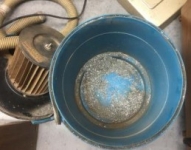The swarf behind my lathe probably contains enough tiny parts to make a whole new engine so I'm intimately familiar with this problem. My approach is more prevention than after-the-fact but future readers of this post may benefit from some of the ideas.
'Sproing' prevention...
When disassembling small mechanisms, do it on a "dead", very short fiber substrate so a dropped part won't bounce. I use a well-worn baby blanket for larger jobs and those freebie, Harbor Freight "micro-fiber" cloths for smaller tasks.
If disassembling something you fear may contain hidden springs, etc. that might try to get away, do the disassembly with your hands and the object inside one of those clear plastic clothes covers the dry cleaners provide when you have your clothes cleaned.
Tweezers with metal tips can propel tiny parts long distances if the part 'squeezes out' of the jaws. Coat the tips of the tweezers with liquid insulation or such to make them a bit sticky.
Make small weighted cups from the bottoms of soda cans...
http://www.homemadetools.net/forum/s...rts-cups-32173
to contain parts removed so they aren't accidentally swept aside off the bench.
Make a fence on the edge(s) of the bench from weather-stripping to prevent roll-off...
http://www.homemadetools.net/forum/one-liners-27189
Attach a piece of brightly-colored pipe cleaner (available in craft stores) to high escape risk parts as soon as they are removed. If they get away the bright color will make them easier to find.*
Turn off the shop radio so, if a part escapes, you might hear the 'ting' when it lands and thus have a general idea of where to look for it.
'Sproing' recovery...
Check your lap before you get up, then check your clothes. Don't wear pants with cuffs.
Lay your flashlight flat on the floor. Even tiny parts will cast a long shadow that's often easier to see than the part itself.
Make a catcher jar for your shop vacuum. It's easier to clean than the vac itself and easier to dump.
---
* This is a good trick for small tools you might use out of doors. Grass is just a natural deep pile carpet. I do this with all the small Allen wrenches I keep in my shooting bag for adjusting sights, etc.. (Just don't use green pipe cleaner; fluorescent orange or yellow is best.)


 LinkBack URL
LinkBack URL About LinkBacks
About LinkBacks


 Reply With Quote
Reply With Quote





Bookmarks